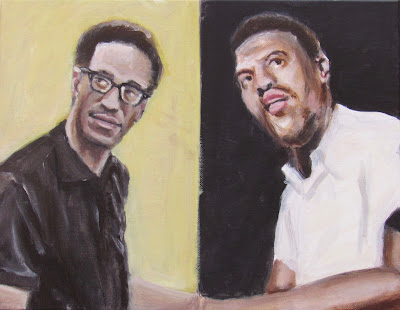 |
| Max Roach/Joe Chambers |
Now the M'Boom recording is not as transformative an experience than hearing, for the first time, the unpretential and spontaneous song a mother gets into when washing her child in the middle of the New Guinean jungle (as recorded by Charles Duvelle in the 1970s) but in a way it's the same sensation be it less removed from my own experience. I have no memory of my mother singing to me and I have no memory of being washed but I do remember seeing jazz concerts. The first shockingly new jazz concert I saw was when I was in my early 20s and saw Han Bennink perform with Mischa Mengelberg. Jazz, perhaps more than other Western type of music, is transformative because it is often improvised and spontaneous. I too have unforgettable experiences of jamming with other musicians right around that time too. These feelings I seek to duplicate in painting now. Painting did become a substitute for music. Painting allows me to transport my being to a different reality, the reality of color and form and creativity. Honestly, as I'm painting this painting representing M'Boom, that delayed conscious state isn't there. Most of the time, making the painting is work. The shift in conscousness is there only in moments, moments of spontenaity and creativity that often occur after lengthy spells of plain work.
 |
|
Alaci Tulaugak, Paul Hodge/Marvin Green, Nellie Nungak |
From: Inuit Throat and Harp Songs: Eskimo Women's Music of Povungnituk recorded in 1979 by Paul Hodge and Marvin Green. The katajjait of Povungnituk in Quebec has characteristics that distinguish them from those of Nunavut (see Nicole Beaudry for example) in that their songs are strictly imitations of the sounds of nature. In Sound of the Wind the sounds of wind blowing through the cracks of an igloo are imitated. Different too is a variation of katajjait that is performed by four women as opposed to the customary two (female) performers standing close to one another.

















